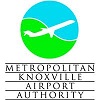
Downtown Island, proposed Oak Ridge airports play complementary roles for region
 (EDITOR’S NOTE: This is the second in a three-part series about air service – past, present and future – in the Knoxville/Oak Ridge Innovation Valley region and beyond.)
(EDITOR’S NOTE: This is the second in a three-part series about air service – past, present and future – in the Knoxville/Oak Ridge Innovation Valley region and beyond.)
The Metropolitan Knoxville Airport Authority (MKAA) has responsibility for two general aviation airports in the region – one in existence and the other that is still in the proposal stage.
In a recent interview with teknovation.biz, MKAA President Bill Marrison reviewed the missions of the two airports and the ways in which they complement each other as well as the Authority’s commercial aviation facility – McGhee Tyson Airport – on Alcoa Highway.
Downtown Island Airport, which opened in 1930 and has gone through several ownerships, became a responsibility of MKAA in January 2006. This airport handles more than 3000 operations a year and has nearly 150 aircraft based on the island. It is land-locked, meaning that growth is not an option.
Its limitations and the expected growth in aviation make the proposed Oak Ridge Airport an important addition to MKAA’s assets. The latter airport would be located on property that formerly housed the Department of Energy’s (DOE) K-25 Gaseous Diffusion Facility. The site, now known as the Heritage Park, is being redeveloped by the Community Reuse Organization of East Tennessee (CROET).
“Everything that is going on (in Oak Ridge) cries for an airport,” Marrison says, citing the increased emphasis that DOE and Oak Ridge National Laboratory (ORNL) place on interactions with the commercial sector.
One of the initiatives that could be a magnet for drawing corporate executives from other states to Oak Ridge is the lab’s work on low-cost carbon fiber and the opening later this year of a $35 million Carbon Fiber Demonstration Facility in the neighboring Horizon Center.
Marrison sees a strategic advantage to Oak Ridge if there is a general aviation facility close to the Oak Ridge assets rather than 45 minutes away. The airport would also assist in the revitalization of the industrial park and prove to be an economic generator bringing jobs and visitors from around the country to the region.
During his 30 years with MKAA, Marrison says that he has seen a change in emphasis by Oak Ridge officials in relation to earlier, unsuccessful efforts to build a local airport. He says the question today is not, “Why does Oak Ridge need an airport,” but “Why doesn’t Oak Ridge have an airport?”
He adds that the proposed Oak Ridge airport would have a longer runway than Downtown Island – 5000 feet versus 3,500 feet, so it would accommodate private and business planes that cannot land at Downtown, increasing the overall capacity of the local aviation system.
“It (Oak Ridge) would serve up to 95 percent of existing business jets,” Marrison noted, adding that private pilots would have a closer facility and even specialized users such as Emergency Medical Services could benefit from an Oak Ridge Airport.
The Oak Ridge facility, together with Downtown Island, would also help alleviate pressure on McGhee Tyson’s general aviation facilities.
In public presentations, Marrison has cited the strong community support for the airport – City of Oak Ridge, DOE, ORNL, Y-12 National Security Complex, and CROET.
MKAA engaged the LPA Group, Inc. to conduct two studies that resulted in the identification of the preferred site in the Heritage Center. The MKAA board of directors formally approved submitting an application to the State of Tennessee for monies to conduct a justification study. That application is awaiting approval, and Marrison said he hopes those dollars will be forthcoming soon.
“Once the economic justification study begins, it will take about 120 days to complete,” he said. This study leads to a number of other actions that are outlined at http://www.oakridgeairport.org/Timeline.html.
The earliest that construction could begin would be at the end of 2017, assuming all studies have been completed and federal funding is available. It is expected to take four years to complete.
NEXT: A look at the early days of the community’s airports.
Like what you've read?
Forward to a friend!

